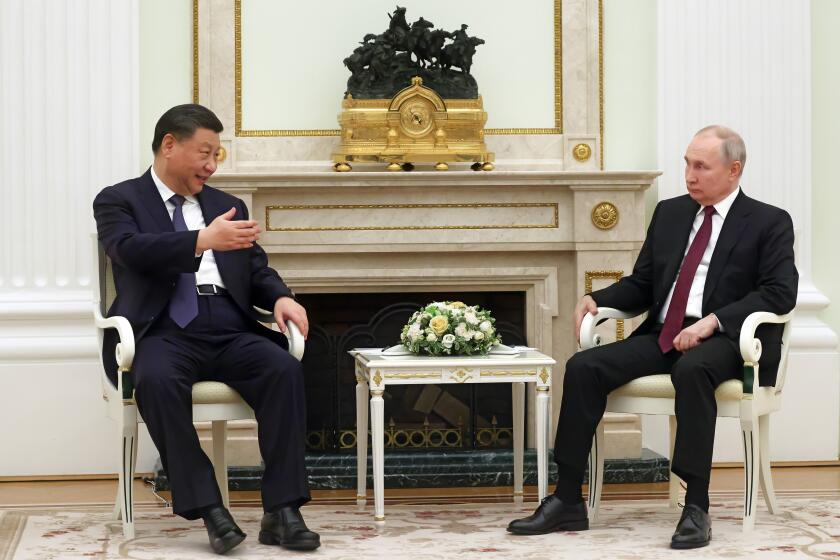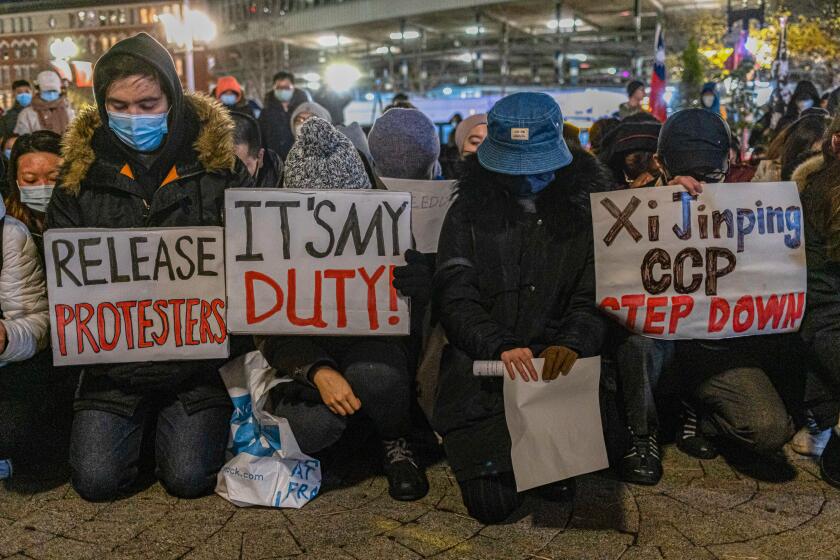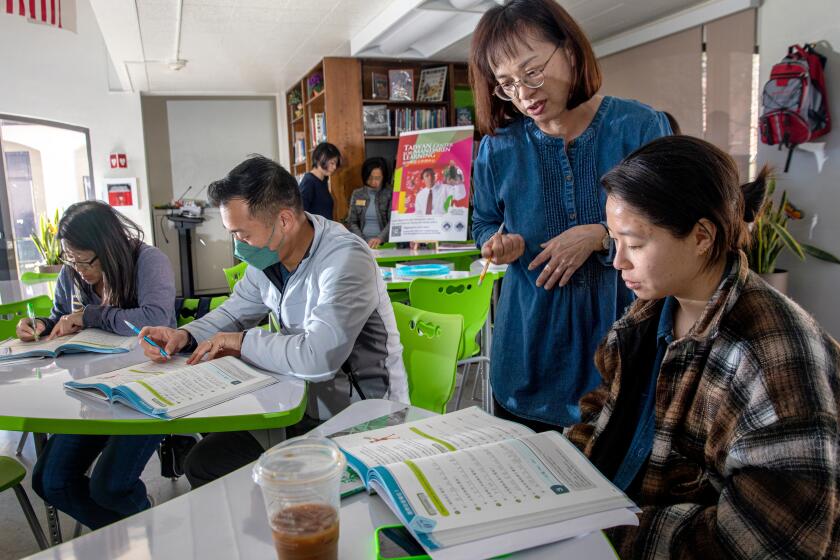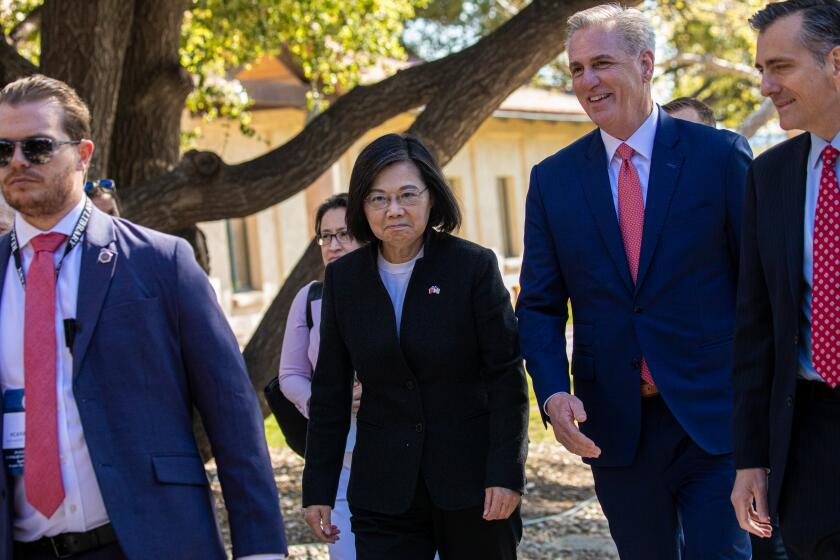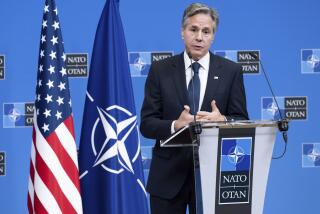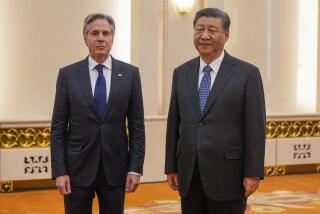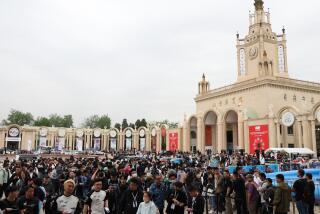After bitter warnings, the U.S. and China are trying to ease hostilities

- Share via
WASHINGTON — After months of acrimony, accusations of espionage and warnings against meddling in each other’s domestic affairs, the U.S. and China this week will attempt to find a way to reopen talks on divisive issues including nuclear warfare, climate change and fentanyl.
U.S. Secretary of State Antony J. Blinken arrived in Beijing on Sunday in the first such high-level contact in China in five years, a potentially momentous diplomatic action that is likely to be only an initial step.
Blinken is making a trip that was scrubbed in early February after the Biden administration detected — and ultimately shot down — what it described as a Chinese spy balloon flying over U.S. territory.
Virtually all contact between the world’s two largest economies slammed shut over the incident, with relations sinking to their lowest level in recent memory.
Tensions were already fraught over a visit in August to Taiwan by then-House Speaker Nancy Pelosi (D-San Francisco). China claims the self-ruled island as its own and is furious when senior U.S. officials appear to give it sovereign recognition.
Now, the Biden administration has decided the time is finally right to launch what would be a long and bumpy journey to rapprochement.
“What we’re working to do on this trip is … to establish sustained, regular lines of communication at senior levels … because if we want to make sure that the competition that we have with China doesn’t veer into
conflict, the place you start is with communicating,” Blinken said Friday in Washington before departing for Beijing.
A new Taiwanese Netflix drama envisions a world of politics with women at the forefront — and tensions with mainland China conspicuously absent.
He said he would seek potential areas of agreement or cooperation, but the more likely outcome is the two nations seeking ways to manage differences.
“Intense competition requires sustained diplomacy to ensure that competition does not veer into confrontation or conflict,” Blinken said. “That is what the world expects of both the United States and China.”
As both he and Chinese diplomats downplayed expectations, the two global powers seem to be far apart on most substantive issues. Yet their economies are
intertwined, making complete rupture next to impossible.
Vladimir Putin is relishing Xi Jinping’s visit and their shared hostility toward the U.S., but not all of Russia’s and China’s interests align.
In addition to the conflict over Taiwan, the U.S. maintains punitive trade tariffs on key Chinese exports and is demanding cooperation on control of Chinese production and marketing of the deadly drug fentanyl.
The Biden administration also wants China to back away from support for Russia in its war on Ukraine, and is alarmed by the diplomatic and economic inroads China is making around the world, especially in Africa and Latin America, where purported Chinese espionage installations in Cuba spying on the U.S. grabbed headlines this month.
Blinken said his two-day mission to Beijing “is an important but, in a sense, insufficient step because there’s a lot of work to be done.”
Even in Boston, China might be watching, these protesters fear. They use fake names, masks and encrypted apps, because even a friend may be a spy.
Days before the trip, Blinken called his Chinese counterpart, Qin Gang, to inform him he expected to conduct what the State Department called “direct and candid conversations” about issues that include human rights and Beijing’s detention of U.S. citizens.
Qin warned Blinken against interfering in Beijing’s domestic affairs, according to the Chinese Foreign Ministry, which added in a statement that the U.S. should respect China’s “core concerns” such as Taiwan.
Part of the Chinese anger comes from an expectation officials there had after President Biden met with Chinese President Xi Jinping in Bali, Indonesia, last fall — that Washington would become less critical of Beijing’s policies and actions. Instead, tensions deepened, especially over Chinese military activities in the Taiwan Strait.
“The Chinese are coming ready to play hardball,” said Carla Freeman, a China expert at the U.S. Institute of Peace in Washington. “They are very cynical about any major takeaways” from meeting with Blinken.
Chinese state media have adopted a contentious tone before Blinken’s arrival, signaling that the country is not anticipating any dramatic reversal in U.S.-China relations.
“Our position is firm: It’s impossible to claim a desire for dialogue while simultaneously suppressing and restraining China,” a state-backed social media account associated with China Central Television said.
At best, the Blinken intervention could clear the way for other senior Biden administration officials such as Treasury Secretary Janet L. Yellen, Commerce Secretary Gina Raimondo and John F. Kerry, presidential envoy for climate, to visit Beijing for talks on their respective portfolios. It is less likely, however, that military-to-military engagement will normalize because Defense Secretary Lloyd J. Austin III’s counterpart, Gen. Li Shangfu, remains blacklisted by the U.S. over purchases of Russian-made weapons in 2018.
Neither side would say whether Blinken and Xi would meet.
“It doesn’t mean they’re going to go back to the good old days, but I think the key word is ‘stabilize,’” said Henry Huiyao Wang, founder of the nongovernmental Center for China and Globalization in Beijing. “I think there is wishful thinking on both sides, but there’s also reality.”
The Taiwanese government hopes to spread its version of Mandarin — along with its values of freedom and democracy — as China’s threats against Taiwan become increasingly bellicose.
For China, the most crucial issue is Taiwan, whose sovereignty quickly became the most sensitive geopolitical matter in the U.S.-China relationship after Xi began calling more forcefully for eventual unification and deploying more military excursions in the Taiwan Strait.
In the shadow of Russia’s war on Ukraine, Biden has said on several occasions that the U.S. would offer military aid to Taiwan if China attacked, though the White House followed up to underscore that the official U.S. policy had not changed. Still, China has accused the U.S. of undermining its “One China” policy, which acknowledges Beijing’s stance that Taiwan is a part of China but stops short of endorsing it.
Such ambiguity has helped preserve peace in the Taiwan Strait for decades, but the delicate balance has grown tenuous, highlighted by several recent near misses between U.S. and Chinese military ships and fighter jets around Taiwan.
“China will be treating Taiwan as a bottom line, hardcore issue and may be implying [that] on this issue we cannot have any compromise,” said Alfred Wu, associate professor at Lee Kuan Yew School of Public Policy at the National University of Singapore.
A visit to California by the current president of Taiwan and a trip to China by her predecessor encapsulate the choices facing the self-ruled island.
The Biden administration has also sought to counter the inroads China has made in many parts of the world, including in the Western Hemisphere, through its multitrillion-
dollar, 10-year-old Belt and Road infrastructure project.
“We have strengthened America’s ability to out-compete China,” said Kurt Campbell, U.S. presidential coordinator for Indo-Pacific affairs, by building the U.S. economy, better protecting U.S. technology “and — critically — by deepening our relationships with allies and partners around the world.”
But the U.S. is playing catch-up. Just in recent weeks, China flexed its influence over a traditionally Russian sphere in Central Asia by gathering Kazakhstan, Kyrgyzstan, Tajikistan, Turkmenistan and Uzbekistan in a summit. And Blinken’s arrival in Beijing was preceded by the visits of the presidents of Honduras and the Palestinian Authority.
Beijing condemns what it sees as U.S. attempts to contain China’s rise. Aside from its frustration over U.S. moves to strengthen ties with Taiwan, China has criticized a defense pact the U.S. formed with the United Kingdom and Australia, known as AUKUS, as well as informal collaboration with “the Quad,” which comprises the U.S., Japan, India and Australia.
Beijing has also bristled at the growing list of Chinese companies subject to a trade blacklist over the use of American technology. Initiatives to prevent Chinese companies from gaining access to sensitive U.S. technology exports have hindered China’s attempts to achieve self-sufficiency in areas such as semiconductor manufacturing and artificial intelligence.
“Without agreement on the fundamental ordering of their places in the world, there is temptation to turn every aspect of their relationships into a battleground for performative one-upmanship,” said Wen-ti Sung, a political scientist with the Australian National University’s Taiwan Studies Program.
As much as the Biden administration is emphasizing its shoring up of alliances to counterbalance China, this is happening in a shifting world order. It is no longer simply West versus East; it is not a complete or exclusive relationship. Numerous countries in the region do not want to be forced to choose between Washington and Beijing but prefer to work with both, depending on their own interests, analysts say.
That message was delivered publicly to Blinken hours before his flight to Beijing, when he held a news conference in Washington with the visiting foreign minister of Singapore, Vivian Balakrishnan.
“As the world transits into a multipolar world, now more than ever we need a rules-based, multilateral system with institutions and processes fit for purpose, updated where necessary,” Balakrishnan said. “This requires the United States and China to achieve a modus vivendi.
“This is a very important and critical moment,” he added, “not just for the United States and China but, indeed, for the rest of the world, [which] will be watching.”
Wilkinson reported from Washington and Yang from Taipei. Special correspondent David Shen in Taipei contributed to this report.
More to Read
Sign up for Essential California
The most important California stories and recommendations in your inbox every morning.
You may occasionally receive promotional content from the Los Angeles Times.

